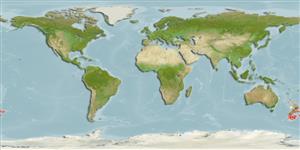>
Perciformes/Cottoidei (Sculpins) >
Psychrolutidae (Fatheads)
Etymology: Ambophthalmos: The name is derived from the Greek adjective 'ambon' (m.) meaning ridge and noun 'ophthalmos' (m.) meaning eye; describing the protruding orbital ridges characteristic of its species.
Environment: milieu / climate zone / depth range / distribution range
Ökologie
seewasser bathydemersal; tiefenbereich 549 - 629 m (Ref. 58018). Temperate
Southwest Pacific: New Zealand (Ref. 5755); Chatham Rise (east of
South Island at 44°S), Bounty Platform (48°S, 180°E), Campbell Rise (52°S, 170°E), and Auckland Island Shelf (50°S, 167°E); and presumed records from Pukaki Rise (49°S, 173°E) and Antipodes Islands (approx. 50°S, 179°E) (Ref. 76761).
Size / Gewicht / Alter
Maturity: Lm ? range ? - ? cm
Max length : 29.0 cm SL Männchen/unbestimmt; (Ref. 38032)
Life cycle and mating behavior
Geschlechtsreife | Fortpflanzung | Ablaichen | Eier | Fecundity | Larven
Paulin, C., A. Stewart, C. Roberts and P. McMillan, 1989. New Zealand fish: a complete guide. National Museum of New Zealand Miscellaneous Series No. 19. 279 p. (Ref. 5755)
IUCN Rote Liste Status (Ref. 130435: Version 2024-2)
Bedrohung für Menschen
Harmless
Nutzung durch Menschen
Tools
Zusatzinformationen
Download XML
Internet Quellen
Estimates based on models
Preferred temperature (Ref.
123201): 6.2 - 9.2, mean 7.4 °C (based on 25 cells).
Phylogenetic diversity index (Ref.
82804): PD
50 = 0.6250 [Uniqueness, from 0.5 = low to 2.0 = high].
Bayesian length-weight: a=0.01000 (0.00244 - 0.04107), b=3.04 (2.81 - 3.27), in cm total length, based on all LWR estimates for this body shape (Ref.
93245).
Trophic level (Ref.
69278): 3.5 ±0.3 se; based on size and trophs of closest relatives
Fishing Vulnerability (Ref.
59153): Low to moderate vulnerability (25 of 100).
Nutrients (Ref.
124155): Calcium = 49 [24, 102] mg/100g; Iron = 0.357 [0.186, 0.672] mg/100g; Protein = 16.3 [13.9, 18.5] %; Omega3 = 0.697 [0.308, 1.943] g/100g; Selenium = 19.2 [8.9, 45.3] μg/100g; VitaminA = 21.8 [6.1, 70.4] μg/100g; Zinc = 0.617 [0.430, 0.909] mg/100g (wet weight);
